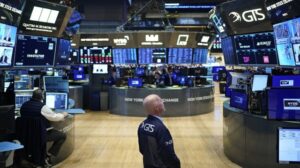Investors’ worst fears of a severe correction in tech stocks that would grip Wall Street as a whole were rekindled in Wednesday’s session, as initial pressure on Big Tech gradually snowballed, leading to dramatic losses across all indices. In fact, for the S&P 500 and Nasdaq it was by far the worst session of 2024.
Specifically, the Dow Jones tried but failed to hold resistance, eventually closing down more than 500 points, down -1.25% at 39,853. In this way, the megacap index, which just days ago celebrated its rise above the 41,000-point milestone, today found itself losing all 40,000 points.
The S&P 500 was also in the… deep red, landing at 5,427 points with a loss of 2.31%, although the sad scepters went to the Nasdaq, which “sank” by 3.64% in its worst session since 2022, and plunged to 17,342 points.
The trigger for the new sell off focused on Big Tech was the results announced last night by Tesla and Alphabet.
Tesla’s results in particular were highly disappointing, confirming the increasing pressure on Elon Musk’s automaker from growing competition and the broader downturn in the EV sector, causing its shares to fall by over 11%.
But it was clear that this was just the trigger. After the tech sector’s stellar first half thanks to the artificial intelligence surge, which drove indices to multiple record highs even at a time when it was clear that the Fed would delay interest rate cuts, many investors began to worry that Big Tech’s high valuations would inevitably lead to a significant technical correction.
In this sense, Tesla and Alphabet’s quarterly results have rekindled questions about the industry’s ability to maintain its upward momentum. At the same time, however, they have fuelled fears that the market as a whole has come to depend too much on the direction of mainly a… handful of tech stocks, notably the famous Magnificent Seven, as Nomura’s Charlie McElligott explained in comments to the FT.
“We’ve been discussing for some time how AI enthusiasm can turn into AI disappointment,” commented Strategas’ Ryan Grabinski on CNBC, noting that the next two weeks will be critical for the market.
A similar view was expressed by Peter Bukvar of The Boock Report speaking to Bloomberg: “Investors are finally realizing that all this spending on AI is more of a burden at this stage than a source of revenue generation.”
It’s no coincidence that no stock in the sector was left unscathed. Tesla and Alphabet recorded their worst sessions since January, while Meta lost nearly 6% and Microsoft close to 4%. The “star” Nvidia, whose value has more than doubled this year, fell more than 6.5% dragging down other semiconductor companies like Broadcom and Arm.
On the flip side, for the fourth straight session and for the 10th time in 11 days, small caps performed much better than large-cap companies.
It is no coincidence that many analysts “see” a more volatile and volatile market picture in the second half of the year against the backdrop of the Fed’s delayed start of monetary easing.
“We see increasing volatility throughout the second half of 2024 with a potential correction in indices of 10% to 15%, particularly in the S&P 500 and Nasdaq 100,” Dan Vadrobsky of Janney Montgomery Scott argued to Bloomberg.
Accordingly, Jose Torres of Interactive Brokers in a note predicted a possible correction centered on the S&P 500 of 10%-15% in the third quarter, which is traditionally the weakest of the year.
In remarks, former New York Fed chairman Bill Dudley called on the board to react immediately to the slowing economy and move to cut rates as early as its upcoming meeting next week, but it is highly unlikely he will be listened to.
Analysts’ forecasts still “see” the first rate cut since September with a possible second cut late in the year, but any serious turbulence on Wall Street combined with the volatile political backdrop is sure to put pressure on the council despite the fact that in theory and form the Fed does not theoretically and formally take into account the advice of either the markets or Washington in setting monetary policy.
In the bond market, trends were mixed with the 10-year yield strengthening to 4.289% and the 2-year yield remaining at 4.429%.
Ask me anything
Explore related questions





